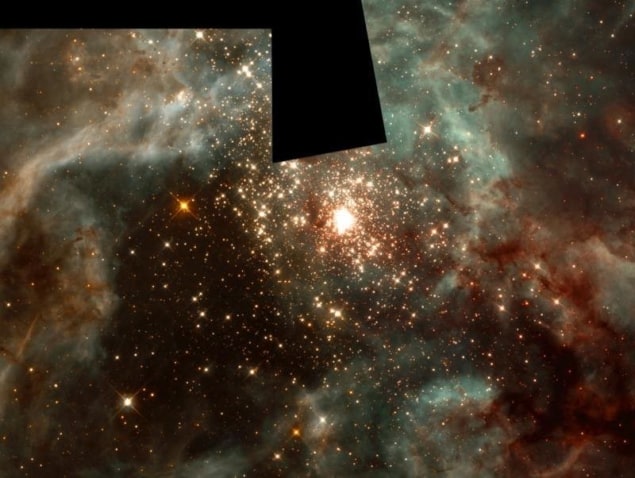
Astronomers in Scotland and Germany say simple physics may explain a long-standing paradox: why large clusters of young stars tend to reside in relatively small galaxies and not in giants like the Milky Way. The reason, according to the astronomers, is that giant spiral galaxies, like the Milky Way, spin fast, shearing star clusters before they grow into monsters.
The stunning 30 Doradus complex is the most luminous nursery of young stars in the Local Group – a collection of several dozen nearby galaxies that includes the Milky Way. It stands to reason, therefore, that 30 Doradus would inhabit an equally impressive galaxy, either Andromeda or the Milky Way, the two largest galaxies in the Local Group.
But instead the stunning 30 Doradus complex lies in the Large Magellanic Cloud, a satellite galaxy of our own that emits only one tenth as much light. The newborn stars of 30 Doradus have set gas aglow over an area 700 light-years wide, 30 times the diameter of the well known Orion nebula.
Rotational inhibition
Now Carsten Weidner and Ian Bonnell of the University of St Andrews in Fife and Hans Zinnecker of the Astrophysical Institute of Potsdam have conducted computer simulations that model interstellar clouds of molecular gas which collapse to form star clusters. Says Weidner, “It seems that rotation inhibits the formation of very massive star clusters.”
Giant spiral galaxies spin fast. For example, the Milky Way rotates at about 230 kilometres per second, and the even larger Andromeda galaxy spins faster still. By contrast, smaller galaxies, such as the Large Magellanic Cloud, rotate slowly.
Weidner’s team ran four computer simulations, each with a different spin speed. “Each model took about a month to compute,” Weidner says. In the fast-spinning models, stars and clusters formed over a wide area, because the spin prevented the gas from collapsing into one gigantic cluster. By contrast, in the slowest-spinning model, the gas collapsed and gave birth to a single huge star cluster at the centre. That model might explain why the huge 30 Doradus complex arose in a galaxy much smaller than our own.
Colliding galaxies
This work also applies to colliding galaxies. Says Weidner, “In the collision region, you have less rotational support, so you would also expect more massive clusters.” In fact, the famous Antennae galaxies – two large spiral galaxies that are smashing together in the constellation Corvus – have created young star clusters far greater than any young clusters in either the Milky Way or Andromeda.
Bruce Elmegreen, a star-formation expert at the IBM Research Division in Yorktown Heights, New York, says the study is interesting, but he’s sceptical of the result. “The connection between galaxy spin and molecular cloud spin is vague,” he says. “Does galaxy spin correlate with the spin of molecular clouds? I’m not aware of an answer to that.” Weidner responds that fast-spinning galaxies should indeed have faster-spinning clouds, because the clouds interact with one another.
What about ‘ram pressure’?
Elmegreen also says that 30 Doradus may owe its great size to factors other than its home galaxy’s slow rotation. The Large Magellanic Cloud – which is only 160,000 light-years from Earth – is plowing through the Milky Way’s halo. Gas in the halo compresses gas in the Large Magellanic Cloud, a process called “ram pressure” that may have sparked the star formation in 30 Doradus.
Weidner acknowledges that ram pressure may have played a role. “30 Doradus is a complex object,” he says, “and we do not claim that we can explain every detail of it. We just say there might be a trend with rotation.”
Weidner and his colleagues will publish their work in The Astrophysical Journal and a preprint (arXiv: 1009.1618) is available.



